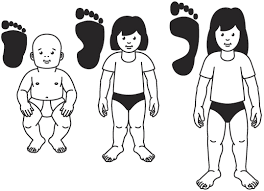
As time passes, you may notice that your child’s growth isn’t completely on the straight and narrow. Many young kids have flatfeet, toe walking, pigeon toes, bowlegs, and knock-knees.
As kids grow, some of these conditions correct themselves without treatment. Others don’t or become more severe because of other medical conditions. But many orthopedic (bone) conditions, just like dimples or cleft chins, are just normal variations of human anatomy that don’t need to be treated.
Flatfeet
Most babies are born with flatfeet and develop arches as they grow. But in some kids the arch never fully develops. Parents often first notice this because their child has what they describe as “weak ankles” (which appear to turn inward because of the way the feet are planted).
Flatfeet usually don’t cause problems. Doctors only consider treatment if it becomes painful. They also don’t recommend any special footwear, such as high-top shoes, because these don’t affect the development of the arch.
Parents sometimes worry that flatfeet will make their kids clumsier than other kids, but doctors say that being flatfooted isn’t a cause for concern and shouldn’t interfere with playing sports. Sometimes, doctors will recommend inserting arch supports into shoes to reduce foot pain.
Toe Walking
Toe walking is common among toddlers as they learn to walk, especially during the second year of life. The tendency often goes away by age 3, although it lasts in some kids.
Occasional toe walking should not be cause for concern, but kids who walk on their toes almost all the time and continue to do so after age 3 should see a doctor. Persistent toe walking in older kids or toe walking only on one leg might be linked to other conditions, such as cerebral palsy, muscle weakness disorders, autism, or other nervous system problems.
If an otherwise healthy child has persistent toe walking, the doctor might recommend a few visits with a physical therapists to learn stretching exercises. Once a child is around age 4 or 5, casting the foot and ankle for about 6 weeks may be needed to help stretch the calf muscles.
In-Toeing (Pigeon Toes)
Babies may have a natural turning in of the legs at about 8 to 15 months of age, when they begin standing. As they get older, parents may notice their children walking with feet turn inward, also called in-toeing, or walking pigeon-toed. In-toeing can have a few different causes that are normal variations in the way the legs and feet line up.
Children who in-toe and trip often may have internal tibial torsion, in which the lower part of the leg is rotated inward. Children over the age of 3 or 4 with in-toeing may have femoral ante-version, in which there is a greater-than-normal bend in the upper part of the leg, which causes the upper leg to rotate inward. In some children, in-toeing can be related to existing medical problems such as cerebral palsy.
Doctors rarely have to treat pigeon-toed feet. Special shoes and braces commonly used in the past were never proved to speed up the natural slow improvement of this condition. In-toeing usually doesn’t interfere with walking, running, or sports, and ends on its own as kids grow into teens and develop better muscle control and coordination.
Bowlegs
Bowleggedness (also called genu varum) is an exaggerated bending outward of the legs from the knees down that can be inherited. It’s common in infants and, in many cases, corrects itself as a child grows.
Bowleggedness beyond the age of 2 or bowleggedness that only affects one leg can be the sign of a larger problem, such as rickets or Blount disease:
- Rickets, a bone growth problem usually caused by lack of vitamin D or calcium in the body, causes severe bowing of the legs and also can cause muscle pain and enlargement of the spleen and liver. Rickets is much less common today than in the past. Rickets and the resulting bowlegs are almost always corrected by adding vitamin D and calcium to the diet. Some types of rickets, however, are due to a genetic condition and may need more specialized treatment by an endocrinologist.
- Blount disease is a condition that affects the tibia bone in the lower leg. Leg bowing from Blount disease is seen when a child is about 2 years old, and can appear suddenly and quickly become worse. The cause of Blount disease is unknown, but it causes abnormal growth at the top of the tibia bone by the knee joint. To correct it, kids may need bracing or surgery when they’re between 3 and 4 years old.
You should also take your child to the doctor if bowleggedness is only on one side or gets progressively worse.
Knock-Knees
Most kids show a moderate tendency toward knock-knees (also called genu valgum) between the ages of 3 and 6, as the body goes through a natural alignment shift. Treatment is almost never needed because the legs usually straighten on their own.
Severe knock-knees or knock-knees that are more pronounced on one side sometimes do need treatment. Devices like braces, splints, and shoe inserts aren’t helpful and are no longer used. In rare cases where children have symptoms such as pain or difficulty running, surgery might be considered after age 10.
Reviewed by: Alfred Atanda Jr., MD
Date reviewed: November 2014
